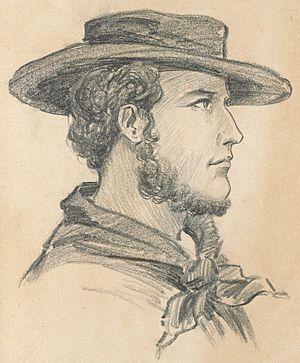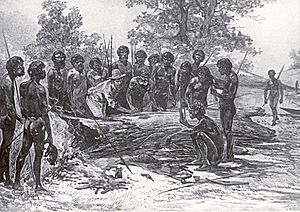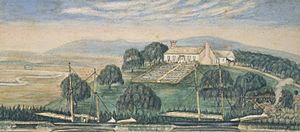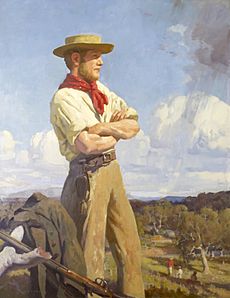John Batman facts for kids
Quick facts for kids
John Batman
|
|
|---|---|

Early-20th-century drawing of Batman, based on an earlier engraving
|
|
| Born | 21 January 1801 |
| Died | 6 May 1839 (aged 38) |
| Burial place | Old Melbourne Cemetery |
| Occupation | Grazier, explorer, pioneer |
| Spouse(s) | Elizabeth Callaghan |
| Children | seven daughters, one son (John Charles Batman drowned 1845) |
| Parent(s) | William Batman, Mary |
John Batman (born 21 January 1801 – died 6 May 1839) was an Australian farmer, businessman, and explorer. He is best known for his important role in the founding of Melbourne, one of Australia's largest cities.
John Batman grew up in the British colony of New South Wales. In the 1820s, he moved to Van Diemen's Land (which is now called Tasmania). There, he became well-known for catching bushrangers (escaped convicts who lived in the bush) and for his part in the Black War. Later, he helped start the Port Phillip Association. This group aimed to find a new place for a settlement on the Australian mainland.
In 1835, Batman led a trip to explore the Port Phillip area. He made a deal, known as Batman's Treaty, with the local Aboriginal people. He offered them tools, blankets, and food in exchange for a huge amount of land. This treaty led to the start of a settlement called Batmania on the Yarra River. This settlement later grew into Melbourne, the capital of Victoria. Batman moved to this new settlement with his wife, Elizabeth Callaghan, and their seven daughters. He settled on a place now called Batman's Hill. He died soon after, at the age of 38.
Batman's treaty was very controversial at the time. The government in New South Wales did not think it was real or fair. However, Batman's treaty is special because it was the only time a European tried to make a deal with Australian Aboriginal people for land, instead of just taking it. It remains an important event in Australian history that people still discuss today.
Contents
Early Life and Moving to Tasmania
John Batman's parents, William and Mary Bateman, came to Sydney in 1797. William had been sent to the Colony of New South Wales as a convict for receiving stolen goods. However, Mary came as a free passenger with their other children. John, their second son, was born on 21 January 1801, in Rosehill, Parramatta. This area is now a suburb of Sydney, but back then, it was one of the first farming settlements in the new colony.
After William was freed, he started a successful timber business. In 1810, the family changed their last name from Bateman to Batman. This might have been to avoid the difficulties of being known as a convict family.
Moving to Tasmania
In 1821, when John was 20, he and his younger brother Henry moved to Van Diemen's Land (now Tasmania). They settled on land in the north-east, near Ben Lomond. John acquired a property called 'Kingston'. It was very large but not great for farming.
In early 1826, Batman became famous for capturing the bushranger Matthew Brady. Brady had been hurt in a fight with authorities but had escaped. Batman went out alone and unarmed. He found Brady, who was injured and in pain, and convinced him to surrender. Brady was then handed over to the authorities and later sentenced to death. Because of this capture, Batman received more land from the government.
Batman became a successful farmer, raising animals. He was also involved in the capture of Tasmanian Aboriginal people in 1829. He even hired Aboriginal people from the mainland to help him hunt Tasmanians. Between 1828 and 1830, many Tasmanians in this area were shot or rounded up by people like Batman.
Batman played a part in the Black War of 1830. During this time, he was involved in the "Black Line." This was a plan to form a human chain across the island to force Tasmanian Aboriginal people from their lands into a smaller, controlled area.
In February 1830, Batman wrote to the British Colonial Secretary, John Burnett. He explained how difficult it was to capture Tasmanian Aboriginal people in the bush. He also asked if he could follow Aboriginal people who were known to have committed crimes, even if they went back to their own land.
The artist John Glover, who lived near Batman in Van Diemen's Land, painted a picture called Batman's Lookout, Benn Lomond (1835). He said Batman used this spot to "entrap the Natives." Glover also described Batman as "a rogue, thief, cheat and liar, a murderer of blacks and the vilest man I have ever known."
By 1835, Batman's property, Kingston, was over 7,000 acres. It had animals, buildings, and many workers. However, it was too rough and rocky to be very productive.
Founding of Melbourne and Batman's Treaty

Batman wanted to get land in the Western Port area, but the government in New South Wales said no. So, in 1835, he became a key member of the Port Phillip Association. He sailed to the mainland on the ship Rebecca and explored much of Port Phillip.
When he found the area where central Melbourne is today, he wrote in his diary on 8 June 1835, "This will be the place for a village." He even called the land "Batmania."
The negotiations for Batman's Treaty with the Kulin people (Aboriginal groups from what is now central Victoria) happened in June 1835. This took place on the banks of the Merri Creek in Northcote, a suburb of Melbourne today. Batman had legal advice from Joseph Gellibrand and help from his Aboriginal companions from New South Wales and Van Diemen's Land.
However, Batman did not visit the main settlement that was later set up on the Yarra River (which became Melbourne) until November 1835. For over a century, people have debated exactly what happened during the founding of Melbourne. In his diary on 8 June 1835, Batman wrote that "the boat went up the river I have spoken of, which comes from the east, and I am glad to state, about six miles up found the river all good water and very deep. This will be the place for a village. The natives on shore." It is not clear if Batman was in the boat that explored the Yarra that day. However, many other British explorers had already noticed how good the site was.
Batman made a treaty with the Kulin people to rent their land each year. In return, he offered them items like blankets, axes, knives, scissors, mirrors, handkerchiefs, flour, and shirts. It is unlikely that the Kulin people understood this as giving up their land forever. However, as Percival Serle wrote, "No doubt the blankets, knives, tomahawks, etc., that he gave them were very welcome."
In any case, Governor Bourke declared the treaty invalid. He said the land belonged to the British Crown, not the Kulin people. Other colonists, including a rival group led by John Pascoe Fawkner, also arrived to settle Melbourne.
Later Life
Batman and his family settled at what became known as Batman's Hill, at the western end of Collins Street. He had sold his property "Kingston" in Tasmania. In April 1836, he brought his wife, Elizabeth Callaghan (who had arrived in Australia as a convict), and their seven daughters to Melbourne. He built a house at the base of the hill. His son, John, was born in November 1837.
Sadly, Batman's health quickly got worse after 1835, causing him constant pain. By the end of 1837, he could no longer walk. He had to stop farming and move into trading and investing. However, he spent too much money and relied too much on others to do his work. As his illness progressed, his face was affected, and he became distant from his wife. In his last months, his Aboriginal servants cared for him, carrying him around in a special chair.
John Batman died on 6 May 1839. After his death, his wife and family moved from Batman's Hill. The government then took over their house for offices. Batman's will, made in 1837, was outdated when he died. Many of the things he left to his children had already been sold. Years of legal arguments followed his death. His wife, Eliza Batman, who had remarried in 1841, was left only £5 in the will. The case continued even after Batman's only son, John, drowned in the Yarra River in 1845. The costs of the legal battle used up what was left of Batman's money.
Legacy
Batman was first buried in the Old Melbourne Cemetery. Later, his body was moved and re-buried in the Fawkner Cemetery. This cemetery is named after his fellow colonist and rival, John Pascoe Fawkner.
A stone monument called an obelisk was built in 1922 to honor Batman. It was later moved to Batman Avenue and then back to the Queen Victoria Market site in 1992. The obelisk has the Latin words "circumspice" carved on it, which means "look around." This suggests that the entire city of Melbourne is his legacy. The obelisk also states that Melbourne was "unoccupied" before John Batman arrived in 1835.
Australian runner Daniel Batman claimed to be a direct descendant of John Batman. However, this claim is doubtful because Batman's only son, John Charles Batman, died in 1845 when he was only 8 or 9 years old.
In recent years, people have started to question Batman's legacy more. Much of the criticism focuses on his actions against Indigenous people in Tasmania. In 2016, the Darebin Council voted to change the name of Batman Park in Northcote. It is now called Gumbri Park, named after Gumbri (Jessie Hunter). She was the great-niece of Wurundjeri leader William Barak and the last girl born at the Coranderrk Aboriginal Reserve.
The Victorian electoral area called the Division of Batman was removed in 2018. It was renamed the Division of Cooper after the Aboriginal political activist William Cooper.
Places Named After John Batman
Many places in Australia are named after John Batman, including:
- Batman Bridge (Tasmania)
- Batman Park (Melbourne CBD)
- Batman's Hill (Melbourne CBD)
- Batman railway station (North Coburg, Melbourne, Victoria)
- Batman Avenue in Melbourne, Keilor Park, Sunbury, Hurstbridge, and Shepparton
- Batman Close in Thornton, New South Wales
- Batman Lane in Surry Hills, New South Wales
- Batman Road in Eltham and Indented Head (his original landing site in Port Phillip Bay)
- Batman Street in Burnside Heights, Footscray, Altona Meadows, Aberfeldie, Fitzroy North, and Portarlington
- Batman Walk in Parramatta
- John Batman Drive in Melton West
- John Batman Gardens in Sandringham
See also
 In Spanish: John Batman para niños
In Spanish: John Batman para niños






